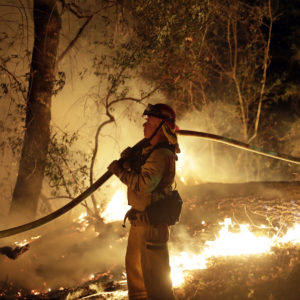California is burning. At the end of last week, fires had destroyed at least 8,400 homes and displaced tens of thousands of residents. In Napa Valley, vintners are already discussing how the 2017 wines will likely have a distinctly smoky palate. Even with more than two dozen fires still burning, California residents are already asking for answers as to the cause of the fire. Several new lawsuits filed last week allege that the Pacific Gas and Electric Company (PG&E) could be liable for the damages that could reach billions of dollars.
The fires have not all been put out, but residents who lost their homes in the blaze are already starting to seek legal action. On Thursday, a couple in Santa Rosa filed the first lawsuit against the company, alleging that the company failed to properly maintain its power infrastructure. In all likelihood, thousands of similar suits will be filed in the coming weeks. California officials are currently investigating whether PG&E was involved in the start of the Tubbs Fire that began on October 8 and has destroyed neighborhoods outside of Santa Rosa.
Similar questions are being asked about the Nuns Fire, which is believed to have started a mere 15 minutes after the Tubbs Fire, and which burned in Napa Valley. Investigators will be examining whether an exploding transformer or downed power lines may have sparked the blazes. Under the state’s liability laws, the utility could also be found responsible for failing to complete necessary maintenance, including trimming trees growing near the lines and placing lines far enough apart that the lines cannot touch.
The results of their investigation could come at a high price for PG&E and, by extension, its customers around the state. CAL FIRE, the state agency responsible for determining the sources of ignition of the fires and the way that the fires spread, explains that it is assessing “the compliance of electric and communication facilities with applicable rules and regulations in fire impacted areas.” If the utility is found to not have been in compliance, it may be subject to state fines. Utilities fined for incidents related to earlier fires paid as little as $2 million (Cox Communications, 2007 Guejito fire) and as much as $37 million (SCE, 2007 Malibu Fire).
State fines will likely be the smallest part of the financial liabilities PG&E faces, however. Attorney Gerald Singleton, of the Singleton Law Firm, which specializes in fire damage, says that present lawsuits are only the beginning of a much longer process of ascertaining the degree of PG&E’s involvement in the fire. The first step in these suits will be to determine the PG&E’s degree of involvement. If, as Singleton expects, the utility is found to be partially liable for the fire, the company could be sued for negligence and damages under “inverse condemnation.”
“Inverse condemnation is the flip side of eminent domain,” he explained. Under California law, a company, such as a utility, that is seen as acting in the government interest can be found liable for damages if it causes property to be lost through its actions. “Negligence allows property owners to collect damages outside of economic losses, including lost wages and personal injury,” he continued.
A full investigation by state officials will likely take between 6 and 12 months. However, investigations related to individual lawsuits will likely be finished sooner. Given the extent of the destruction, both the damages and liability that PG&E faces will likely be costly.
“We could conceivably be looking at damages from these fires being anywhere from $10 to $12 billion,” Singleton says. “But out of that, the inverse condemnation damages could conceivably be passed on to the ratepayers.”
If approved by the public utility commission, rate increases could cover 60-70 percent of the utility’s liabilities, Singleton explained. Typically, the commission has approved damages related to inverse condemnation and the everyday operation of the public utility. However, the commission has been less likely to grant emotional distress and similar suits, which it sees as the responsibility of shareholders. This means that PG&E will likely be liable for between 25 and 30 percent of damages, with the remainder passed along to ratepayers over a period of years.
“When you balance that out, it isn’t a particularly big increase,” Singleton says, “particularly if you balance that out over a period of two to three years.”
Despite the massive losses, the damage payments might not sink PG&E, given its massive size. PG&E is one of the nation’s largest utility companies, providing natural gas and electricity to more than 16 million people across a a 70,000-square-mile area of northern and central California.
Even as firefighters continue to work to contain the fires, at least one legislator is calling for the utility company to be broken up.
Democratic state Senator Jerry Hill has been pushing to reform the utility company since the San Bruno blast in 2010 and now warns that he will push to break up the utility if it is found that negligence caused the present fires.
“They’ve crossed the line too many times. They need to be dissolved in some way, split,” he told local papers.
The decision to divide the company would rest with shareholders and would likely hinge on if the utility is found negligent or not. Until the fires are out, it will be impossible to determine what changes ratepayers will face as a result of the fires. Still, given the extent of the destruction, it seems that PG&E and its customers will likely pay millions.

